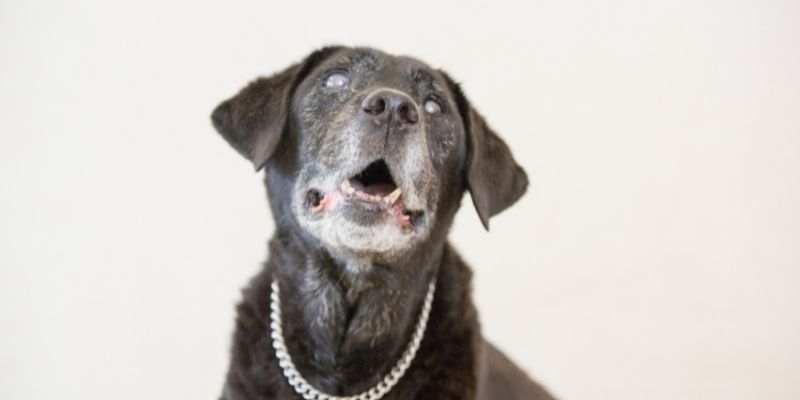As a dog owner, canine cataracts may be something that you’ve been thinking about. Eye problems in general and cataracts, in particular, can cause concern for pet parents. Amongst the various eye problems in dogs, canine cataracts are definitely worth knowing about. Can cataracts in dogs be treated without surgery is a question raised by many dog owners. Let’s address this vital question and everything related to canine cataracts here.
Do you have a specific question about treating cataracts in dogs without surgery? Then use the table of contents below to jump to the most relevant section. And you can always go back by clicking on the black arrow in the right bottom corner of the page. Also, please note that some of the links in this article may be affiliate links. For more details, check the Disclosure section at the bottom of the page.
Here's what we'll cover:
Canine cataracts: what is it?
It’s essential to understand the meaning of canine cataracts before answering the question: can cataracts in dogs be treated without surgery? If you don’t understand whether your dog has a cataract or some other eye problem, treating the issue can be complicated and confusing.
Physiologically speaking, dogs’ eyes are very similar to humans. They have rods, cones, pupils, corneas, and lenses-just like human eyes! So, canines and humans are prone to similar eye problems, cataracts being one of them.
As dogs age, they may develop canine cataracts just like humans do. For example, when the lens of a canine’s eyes becomes cloudy, it is called a cataract. Cataracts occur due to changes in the protein composition in the lens or the water balance in the lens.
Cataracts look like a cloudy layer on the eyes. Owing to the lens becoming cloudy, very little to no light reaches the retina of the eyes. Therefore, cataracts lead to blindness in canines.
A mature cataract can make the black portions of a dog’s eyes look completely white. It basically looks like a white disk behind your canine’s iris.
Cataracts can begin as a spot and grow with time. It may affect one or both eyes of a canine and can cause partial to complete blindness.
The causes of cataracts in dogs
Understanding the cause of canine cataracts can also play a role in treating cataracts in dogs. So, understanding the cause of cataracts also helps address the question- can cataracts in dogs be treated without surgery?
Here are some probable causes of canine cataracts:
- Diabetes mellitus in dogs can lead to cataracts
- Eye injuries that have resulted in inflammation of your dog’s eyes can cause canine cataracts.
- Canine cataracts can also be transmitted genetically. It’s an inheritable trait.
- Age is a leading cause of canine cataracts. As your dog ages, the chances of your pet developing a cataract also increase.
Does my dog have a canine cataract?
So, can cataracts in dogs be treated without surgery? To find that out, it’s best to be well-versed with the common symptoms that your dog may be showing if they have a canine cataract. Here are some of the common symptoms of cataracts in dogs:
- Cloudy pupils (either one eye or both eyes)
- Changes in eye color
- Changes in the shape and/or size of your dog’s pupil
- Watery eyes
- Squinting
- Clumsiness
- Inability to judge distances
- High-stepping and unusual walking style
- Frequently bumping into furniture and inability to recognize familiar people (signs of vision loss)
- Difficulty in climbing and/or jumping
- Scratching and rubbing the eyes
Treatment of canine cataracts- is non-surgical treatment possible?
Finally, let’s address the question: can cataracts in dogs be treated without surgery? After you’ve contacted the vet and the diagnosis of canine cataract has been confirmed, it’ll be time to decide whether you’d like your dog to go for cataract surgery or not.
The treatment of cataracts is that cataract surgery is the only remedy to restore functional vision and completely remove the cataract. The surgery is performed under general anesthesia. In this surgery, the cloudy lens is removed by the veterinary ophthalmologist. After that, a lens made from acrylic or plastic is placed.
Because cataract surgery in dogs must be performed under general anesthesia, not all dogs may be suitable candidates for the surgery. Dogs with eye conditions like damaged retinas or glaucoma or health issues like kidney or heart issues won’t qualify for this surgery.
In these cases, the vet usually prescribes long-term anti-inflammatory eye drops. Unfortunately, these eye drops don’t restore eyesight or treat cataracts. However, they’re effective in preventing inflammatory diseases like glaucoma.
Remember that taking safety measures to preserve your furry friend’s vision is your best bet. Proper post-surgery care is also vital to ensure that your dog recovers properly from the cataract surgery.
Thanks for the blog graphics: Canva.com

Thanks for the blog graphics: Canva.com
Doghint.com is a participant of several affiliate programs. The list includes (but not limited to) the following: VigLink, Refersion, ShareASale, and Amazon Services LLC Associates Program, an affiliate advertising program designed to provide a mean for us to earn fees by linking to Amazon.com and affiliated sites. Doghint.com does not intend to provide veterinary advice. All published articles are meant for informational purposes only and not substitute the professional veterinary consultation.


